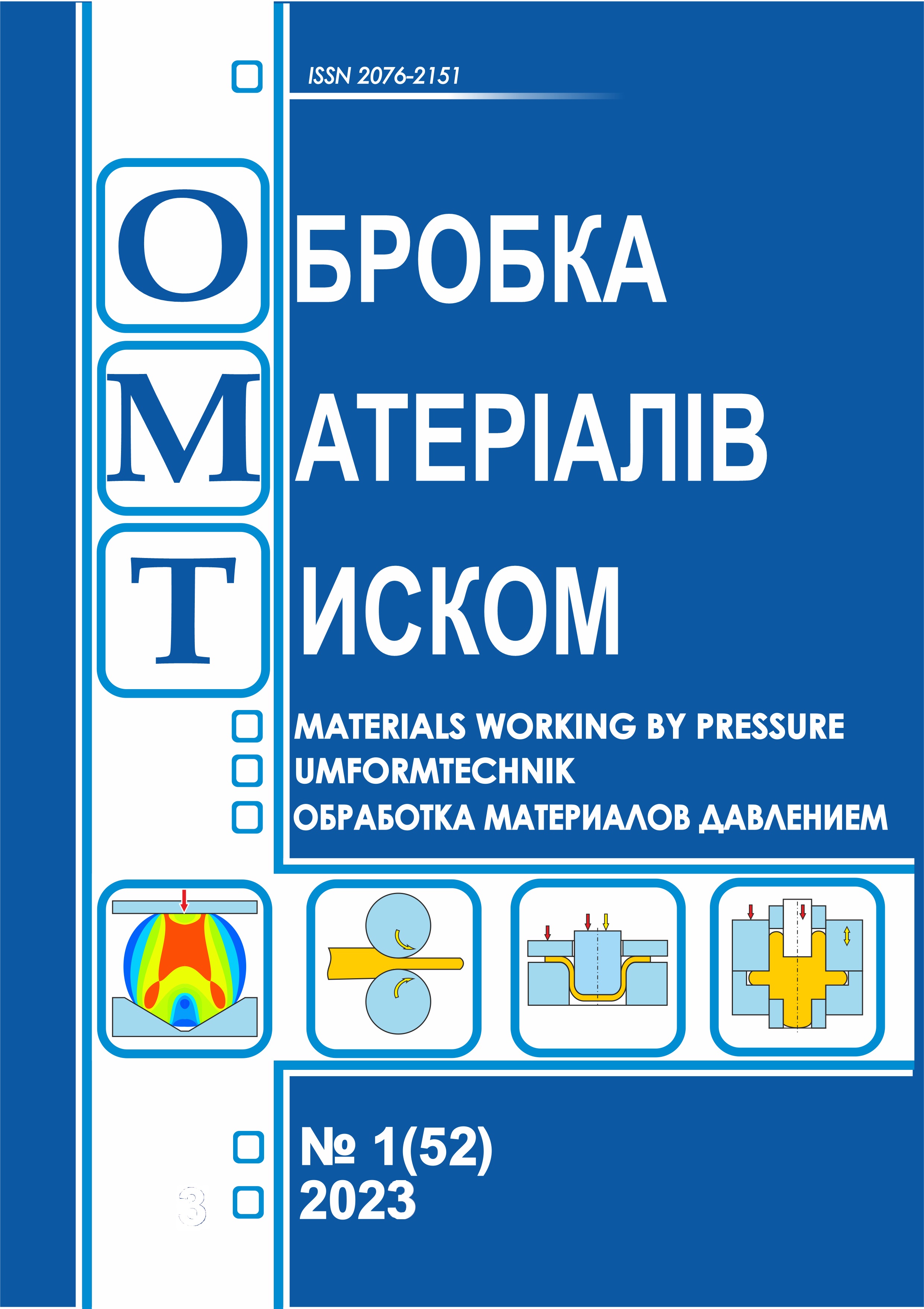Experimental study of the rolled metal straightening on multi-roll leveler
DOI:
https://doi.org/10.37142/2076-2151/2023-1(52)138Keywords:
plate, straightening, leveling machine, mathematical model, finite element model, experimental studies, force measurement.Abstract
Gribkov E., Dobronosov Yu., Kovalenko A. Experimental study of the rolled metal straightening on multi-roll leveler
Straightening of rolled sheets plays an important role in shaping the quality characteristics of the finished product. Modern metallurgical plants use multi-roller sheet straightening machines with individual roller settings. These machines have a flexible system of technological settings, which requires a mathematical model of the plate levelling to solve computer-aided design problems. Moreover, if for steels for general engineering purposes the rational value of the position of the rollers is in a wide range, then for high-strength steels this is a very narrow field, requiring a very accurate result from the mathematical model. The most accurate models are those based on the finite element method. In this work, a finite element model of the plate straightening process in a multi-roller machine was developed. To verify the adequacy of the developed model, experimental studies were carried out in laboratory conditions. The laboratory setup was a 9-roller sheet straightening machine with a roller diameter of 100 mm, located at 105 mm pitches. The rollers were adjusted using a screw mechanism. The study was carried out for a 5-roller version of the machine. All rollers were driven. Experiments were carried out for sheets of three thicknesses: 2.5, 3.5 and 9.0 mm. The width of the sheet for a thickness of 2.5 mm was about 150 mm, for the rest - 100 mm. 4 sheets of each thickness were used. The straightening force was measured using ring gauges installed between the pressure screw and the roller pad. An ADC was used to process the signal. Comparison of experimental data on plate straightening processes with calculation results indicates their qualitative and quantitative agreement. At the same time, the error in calculating the straightening force on the third roller did not exceed 16.5 %. The comparison shows a sufficient degree of reliability of the developed mathematical models and the possibility of their application on existing industrial equipment.
References
Gribkov E.P., Kovalenko A.K., Hurkovskaya S.S. Research and simulation of the sheet leveling machine manufacturing capabilities. International Journal of Advanced Manufacturing Technology. 2022. Vol. 120(1-2), pp. 743-759. DOI: https://doi.org/10.1007/s00170-022-08806-z
Hernández U. U. et al. Friction characterisation in levelling processes. Advances in Materials and Processing Technologies. 2016. Vol. 2, no. 4, pp. 503-513. DOI: https://doi.org/10.1080/2374068X.2016.1247230
Won C., Lee W., Lee H.-Y., Kang Y.-S., Yoon J. Evaluation of in-plane edge stretchability under severe contact condition for third-generation advanced high-strength steel. International Journal of Advanced Manufacturing Technology. 2020. Vol. 108, pp. 1945-1958. DOI: https://doi.org/10.1007/s00170-020-05537-x
Fan Q.-H., Zhang H., Jiang X.-C., Tian B.-Z. Study on neutral layer offset of high-strength steel plate straightening of excavator's working arm. Advances in Mechanical Engineering. 2017. Vol. 9, no. 7. DOI: https://doi.org/10.1177%2F1687814017712420
J.-B. Lee and S.-S. Kang, “Numerical Modeling of Roller Leveler for Thick Plate Leveling. International Journal of Precision Engineering and Manufacturing. 2018. Vol. 19, no. 3, pp. 425–430. DOI: https://doi.org/10.1007/s12541-018-0051-x
N. Mathieu, R. Dimitriou, A. Parrico, M. Potier-Ferry and H. Zahrouni. Flatness defects after bridle rolls: a numerical analysis of levelling. International Journal of Material Forming. 2011Vol. 6, no. 2, pp. 255–266. DOI:https://doi.org/10.1007/s12289-011-1083-2
A. V. Barabash, E. Yu. Gavril’chenko, E. P. Gribkov and O. E. Markov. Straightening of Sheet with Correction of Waviness. Steel in Translation. 2014. Vol. 44, no. 12, pp. 916–920,. DOI: https://doi.org/10.3103/S096709121412002X
B. Dratz, V. Nalewajk, J. Bikard and Y. Chastel. Testing and modelling the behaviour of steel sheets for roll levelling applications. International Journal of Material Forming. 2009. Vol. 2, pp. 519–522. DOI: https://doi.org/10.1007/s12289-009-0560-3
S.-Y. Tsai and J.-Y. Chang. Design of deep learning on intelligent levelling system for industry 4.0 technology. MATEC Web of Conferences. 2018, Vol. 185, article no. 00026. DOI: https://doi.org/10.1051/matecconf/201818500026
Z. Liu et al. Boundary determination of leveling capacity for plate roller leveler based on curvature integration method. Journal of Central South University. 2015. Vol. 22, pp. 4608-4615. DOI: https://doi.org/10.1007/s11771-015-3011-y
Z. Liu et al. An analytical study of optimal roller intermeshes for the plate leveling process. Proceedings of the Institution of Mechanical Engineers, Part B: Journal of Engineering Manufacture. 2021. Vol. 235, no. 1-2, pp. 278-289. DOI: https://doi.org/10.1177%2F0954405420947959
L. Cui, X. Hu and X. Liu. Research on Mathematical Model of Leveling Process for Plate Mill. Advanced Materials Research. 2011. Vol. 148–149, pp. 368–371. DOI: https://doi.org/10.4028/www.scientific.net/AMR.148-149.368
Y. Wang, Z. Liu and X. Yan. Evaluation of straightening capacity of plate roll straightener. Journal of Central South University. 2012. Vol. 19, no. 9, pp. 2477-2481. DOI: https://doi.org/10.1007/s11771-012-1299-4
Yi Guodong, Zili Wang and Zhouyu Hu, “A novel modeling method in metal strip leveling based on a roll-strip unit. Mathematical Problems in Engineering. 2020. Vol. 2020, Article ID 1486864,. DOI: https://doi.org/10.1155/2020/1486864

